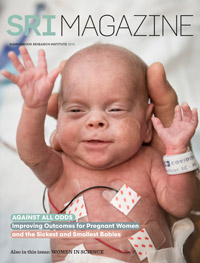Through the wormhole


Virginia Apgar created a test that is still used to determine the health of babies.
Photo: United States Library of Congress (public domain) via Wikipedia Commons
Asked by a medical student what to look for when assessing a newborn’s health, American anesthesiologist Virginia Apgar (1909–1974) swiftly scrawls a few notes on a piece of paper. Unbeknown to her, she’s just drafted a list of signs that will become her claim to fame—one she will develop further and publish in 1953, and that will be practised around the globe as a test to evaluate quickly the state of newborns.
Still used today, the appropriately titled Apgar score is a simple test that involves reviewing a baby’s appearance, pulse, grimace, activity and respiration upon delivery, and assigning a grade to each factor. Zero, one or two are the options—in other words, poor, fair or normal—and a total of seven out of 10 means the baby is healthy. If the total is less than seven, then the test is repeated at five-minute intervals until a score of seven or higher is achieved.
The result immediately indicates whether a baby requires extra attention and helps care teams decide on treatments from heart monitoring to resuscitation. The test is widely praised for increasing neonatal survival rates at a time when the focus of medical professionals was on mothers, an approach that led to many newborn deaths.
In addition to shaping the course of neonatology, Apgar helped blaze the trail for women in medicine by becoming the first female at Columbia University to hold full professorship in 1949.



